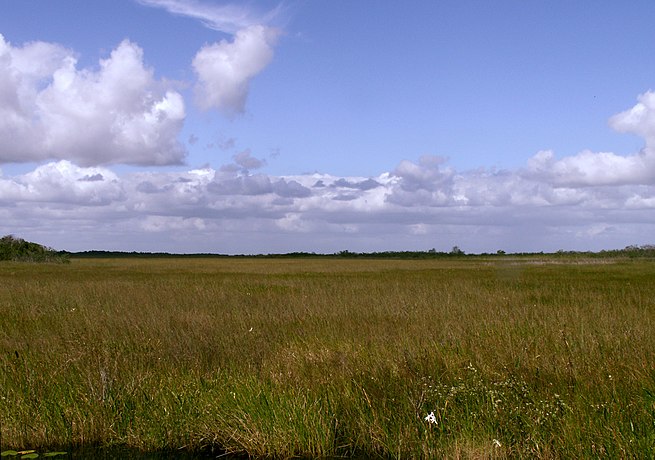Main Difference
The main difference between Everglades and Bayou is that the Everglades is a natural region of tropical wetlands in Florida, United States and Bayou is a Franco-English term for a body of water typically found in flat, low-lying area
-
Everglades
The Everglades is a natural region of tropical wetlands in the southern portion of the U.S. state of Florida, comprising the southern half of a large drainage basin within the Neotropical realm. The ecosystem it forms is not presently found anywhere else on earth. The system begins near Orlando with the Kissimmee River, which discharges into the vast but shallow Lake Okeechobee. Water leaving the lake in the wet season forms a slow-moving river 60 miles (97 km) wide and over 100 miles (160 km) long, flowing southward across a limestone shelf to Florida Bay at the southern end of the state. The Everglades experience a wide range of weather patterns, from frequent flooding in the wet season to drought in the dry season. Throughout the 20th century, the Everglades suffered significant loss of habitat and environmental degradation.
Human habitation in the southern portion of the Florida peninsula dates to 15,000 years ago. Before European colonization, the region was dominated by the native Calusa and Tequesta tribes. With Spanish colonization, both tribes declined gradually during the following two centuries. The Seminole, formed from mostly Creek people who had been warring to the North, assimilated other peoples and created a new culture after being forced from northern Florida into the Everglades during the Seminole Wars of the early 19th century. After adapting to the region, they were able to resist removal by the United States Army.
Migrants to the region who wanted to develop plantations first proposed draining the Everglades in 1848, but no work of this type was attempted until 1882. Canals were constructed throughout the first half of the 20th century, and spurred the South Florida economy, prompting land development. In 1947, Congress formed the Central and Southern Florida Flood Control Project, which built 1,400 miles (2,300 km) of canals, levees, and water control devices. The Miami metropolitan area grew substantially at this time and Everglades water was diverted to cities. Portions of the Everglades were transformed into farmland, where the primary crop was sugarcane. Approximately 50 percent of the original Everglades has been developed as agricultural or urban areas.Following this period of rapid development and environmental degradation, the ecosystem began to receive notable attention from conservation groups in the 1970s. Internationally, UNESCO and the Ramsar Convention designated the Everglades a Wetland Area of Global Importance. The construction of a large airport 6 miles (9.7 km) north of Everglades National Park was blocked when an environmental study found that it would severely damage the South Florida ecosystem. With heightened awareness and appreciation of the region, restoration began in the 1980s with the removal of a canal that had straightened the Kissimmee River. However, development and sustainability concerns have remained pertinent in the region. The deterioration of the Everglades, including poor water quality in Lake Okeechobee, was linked to the diminishing quality of life in South Florida’s urban areas. In 2000 the Comprehensive Everglades Restoration Plan was approved by Congress to combat these problems, which at that time was considered the most expensive and comprehensive environmental restoration attempt in history; however, implementation faced political complications.
-
Bayou
In usage in the United States, a bayou ( or , from Cajun French) is a body of water typically found in a flat, low-lying area, and can be either an extremely slow-moving stream or river (often with a poorly defined shoreline), or a marshy lake or wetland. The term bayou can also refer to a creek whose current reverses daily due to tides and which contains brackish water highly conducive to fish life and plankton. Bayous are commonly found in the Gulf Coast region of the southern United States, notably the Mississippi River Delta, with the states of Louisiana and Texas being famous for them. A bayou is frequently an anabranch or minor braid of a braided channel that is moving much more slowly than the mainstem, often becoming boggy and stagnant. Though fauna varies by region, many bayous are home to crawfish, certain species of shrimp, other shellfish, catfish, frogs, toads, American alligators, American crocodiles, herons, turtles, spoonbills, snakes, leeches, and many other species.
-
Bayou (noun)
A slow-moving, often stagnant creek or river.
-
Bayou (noun)
A swamp, a marshy (stagnant) body of water.

